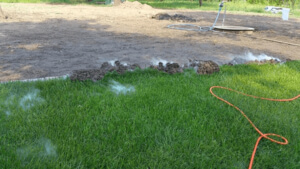- Show results for
- Share
How To Get Rid Of Moles In Your Yard And Garden
Resource Description

Moles in the yard are like unbidden guests - are welcome when they are gone. A terror of beds, lawns, and gardens. Alone, it can build tunnels with a total length of up to 650 ft. (200 meters). Imagine the disaster when a friendly family of these "harmful" mammals encroaches on your yard. With this in mind, Mega Depot has prepared for you some useful tips on How to Get Rid of Moles. In this article, you will learn:
- Who threatens the harvest?
- It seems to be not an enemy
- What prominent features do moles have?
- How to get rid of ground moles in natural and modern ways?
- How do solar mole repellers work?
Who threatens the harvest?
To make you happy with the harvest, you still have to protect the beds from yard pests. And for this, you need to know the enemies you’re about to meet.

Gophers. Gophers, or so-called pocket gophers (have external cheek pockets that allow them to carry food and nesting materials) are burrowing rodents with powerful forepaws. They can be 6 to 10 inches long, depending on the species. Gophers usually feed on the roots and fleshy parts of plants, but they also can pull whole plants into the ground. They feed on many garden crops, ornamental plants, vines, shrubs, and trees.

Voles. Voles are vegetarians. They have short tails, small round bodies, little eyes, and partially visible ears, making them easily mistaken for field mice. Voles are 5 to 8 inches long and are grayish-brown. They make small golf-balls-like holes out of former mole tunnels. Mainly, voles like to live in mulch, heaps of leaves and grass, and high ground covers. Voles are the smallest and most productive members of the rodent family.

Groundhogs. Groundhogs, or woodchucks, have dark brown or black feet and a thick bushy tail. They weigh less than 2 pounds. Groundhogs dig deep burrows, but unlike a mole, their move is in throwing out the ground from the side. The burrow has many entrances and exits, several nesting chambers where groundhogs stockpile and breed. Moves can be up to about 82 ft. (25 meters) in length and are located at a depth of 2-13 inches.

Moles. Moles are meat-eaters and love to snack on insects, earthworms, and grubs. These little critters are 4 to 7 inches in length with small, paddle-like feet. If you see holes around your yard, this is a clear sign of mole activity. Mole mounds have a rounded volcano shape and an indistinct plug in the middle. Unlike gophers, moles have foraging burrows just below the surface, forming a towering trail on your land.
It seems to be not an enemy

It should be remembered that a mole is a link in the biocenosis, and a significant one, with a plus sign. Thanks to this small worker’s "digging" activity, a layer of soil, rich in humus, is carried to the surface. The result is a kind of plowing. This contributes to the speedy transformation of plant residues into humus and the germination of seeds. Besides, dug holes serve to aerate the soil.
A mole predominantly feasts on earthworms. Also, grubs, insects, and their larvae, which are hungry for juicy roots inhabiting the fruit beds, make up a considerable part of its diet. It gnaws plants solely by misunderstanding. The shallow depth of the burials leaves no chance for plant roots to survive. The mole doesn’t feed on them but spoils them while moving underground.
So, it seems, the mole is not such a pest, but not every gardener is ready to calmly relate to the undermined beds and lawns.
What prominent features do moles have?
The fight against moles will become more effective if you take into account the habits and features of this animal:
- Due to their active lifestyle, they consume a significant amount of food. It is in search of food that they break through the network of passages in the soil. Moles do not abandon the moves they have made, but return and check them almost every hour.
- Animals rarely get to the surface, preferring an underground lifestyle.

- Despite the small size, it is not recommended to catch the animals by hand. Their claws and teeth are capable of inflicting serious wounds on humans.
- The mole is very careful: unfamiliar sounds and smells frighten it. This animal sees poorly but hears and feels well. Quick-witted, it can also avoid prepared traps.
- For the winter, the animal digs deep holes and hibernates in them. Hibernation can be determined by a large volume of raised soil at the highest point of the site.
Having estimated the scale of damage and habits of the animal, you should start fighting moles.
How to get rid of moles in natural and modern ways?
The fight against moles in the yard has been carried out since ancient times. This is what determines the variety of available methods for expelling a yard pest from the site.
Many people consider moles to be indicators of a favorable ecological situation, so they rejoice at their arrival. But they get rid of them, destroying everything in the area, spilling the soil with kerosene, alcohol, and other poisons. Moles leave, but so does life from the soil.
Safe pet-friendly ways to keep moles out of your garden or yard are:
- Use of plant repellents. Plants produce chemicals that act as natural means of repelling pests, and since ancient times they have been used to repel insects, most often by burning plant material. Daffodils, imperial hazel grouse, marigolds, scilla siberica, or lavender are not liked by the animals for their smells. It is enough to plant them around the perimeter of the site.
- Adding strong-smelling substances to burrows - rags moistened with oil products or naphthalene. Fish waste is also suitable for use. Pungent odors scare away the pest.
- Noise devices. Besides harsh odors, they dislike loud or annoying noise and vibration. You can get rid of moles in the country in a simple way by making homemade turntables from plastic containers or aluminum cans and placing them throughout the site.
- Filling the moves. If there is free and unrestricted access to water, you can try to flood the mole passages. The process should continue for at least several hours, several days in a row.
 Calcium
carbide. When
exposed to water, pieces of the substance added to the minks begin to emit gases that irritate the mucous
membranes. Moles rush to leave the dangerous place and leave the site. However, the opposite effect is also
known, when the animals dug new moves to replace the spoiled ones.
Calcium
carbide. When
exposed to water, pieces of the substance added to the minks begin to emit gases that irritate the mucous
membranes. Moles rush to leave the dangerous place and leave the site. However, the opposite effect is also
known, when the animals dug new moves to replace the spoiled ones.- Manual capture of animals. Moles quickly restore destroyed areas, so you can use this method when the pest first appears. A glass jar or other container with slippery edges is dug in at a slight angle to prevent the mole from escaping. Within a few hours, the animal can fall into a homemade trap. It is important to release the prisoner away from your site to exclude its return.

Effective control of moles on the site is carried out using modern methods. Special means are aimed at irritating the auditory and olfactory receptors of the mole. So, let's consider the three most widely used humane ways to make moles leave your garden.
1. Castor Oil
 Castor oil is the most popular ingredient in mole
repellents as moles can’t stand its smell and taste. Castor oil will not kill moles, but it will cause digestive
upset for them, making your lawn a less attractive place to live.
Castor oil is the most popular ingredient in mole
repellents as moles can’t stand its smell and taste. Castor oil will not kill moles, but it will cause digestive
upset for them, making your lawn a less attractive place to live.
A homemade recipe is simple: Three parts of oil mixed with one part of shampoo or dishwashing detergent, diluted in a bucket of water. Spray the castor oil concentration a little at a time, trying to cover as much of the area as possible. Remember to reapply homemade mole repellant after rain or watering.
2. Fence the yard
 The
safest and most humane way to preserve your
harvest and not ditch all living things is simply not to let moles enter the site - fence the yard from them. To do
this, dig in a fine mesh netting to a depth of at least 1.5 ft. along the perimeter of the site. Time-consuming
business, but worth it. There is no need to fasten the mesh, it should rise no more than 1 ft. above the soil.
Animals do not descend either higher or lower.
The
safest and most humane way to preserve your
harvest and not ditch all living things is simply not to let moles enter the site - fence the yard from them. To do
this, dig in a fine mesh netting to a depth of at least 1.5 ft. along the perimeter of the site. Time-consuming
business, but worth it. There is no need to fasten the mesh, it should rise no more than 1 ft. above the soil.
Animals do not descend either higher or lower.
The mesh will last from 5 to 8 years, then the oxidation processes will do their job and destroy it. Do not forget to mark the edges of the net, otherwise, you risk injuring your legs.
3. Ultrasonic Mole Repellent
 Electronic
scarers. They are based on irritation
of the animal's receptors using high-frequency ultrasound and infrasound. Such devices are easy to install and, if
necessary, rearrange to a new place. This is where Bird-X's
Transonic Solar Mole Repeller is the best. Most importantly, the frequencies produced by the devices
are not audible to humans, therefore they do not irritate the hearing.
Electronic
scarers. They are based on irritation
of the animal's receptors using high-frequency ultrasound and infrasound. Such devices are easy to install and, if
necessary, rearrange to a new place. This is where Bird-X's
Transonic Solar Mole Repeller is the best. Most importantly, the frequencies produced by the devices
are not audible to humans, therefore they do not irritate the hearing.
Notice that the repellent does not completely eliminate moles. They cause them to move from one location to another, that is from your property to your neighbors. You’ll make a nice decision by informing them in advance.
How does Transonic Solar Mole Repeller work?
The Bird-X solar-powered mole repeller converts the light energy from the sun into power for the vibration mechanism of the anti-mole device.
A cylindrical body of the repeller, immersed in the ground, transmits vibrations from an electronic actuator to the surrounding layers.
Oscillations, reaching the auditory and tactile system of underground rodents cause irritation and fear, which sooner or later leads to the expulsion of the mole from your site, garden, or lawn.
Transonic mole repeller combines ultrasound, vibration, and flashing light, which makes it more versatile.

|
The best place to install a mole repeller is an open garden or lawn where traces of moles most often appear. The place should be open so that vibration doesn’t meet obstacles and the solar battery can be fully charged all day. Such a device is enough to reliably and effectively protect a site with an area of up to 50 ft. radius, approximately 7,800 sq. ft. You should think about how to get rid of a mole immediately when the first moves and mounds appear. The more ramified the underground network, the more time and money is spent to get rid of the garden pests. Moreover, we agree that the fight against moles on the site should be not only efficient but also humane. Therefore - no pesticides or death traps. It is better to try to make sure that the moles bypass your area. |

